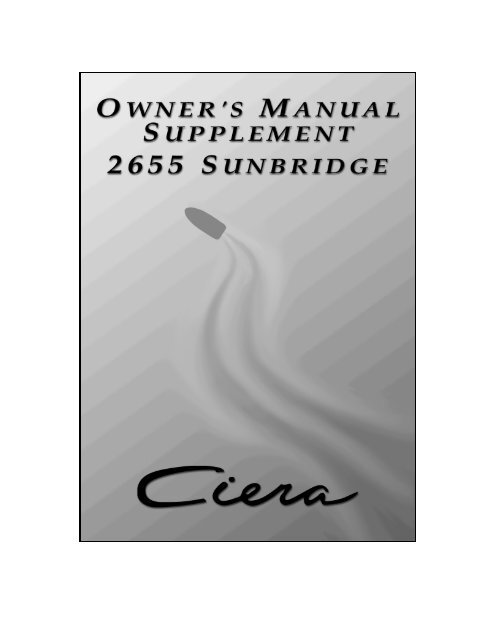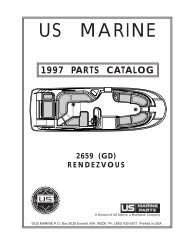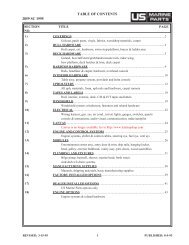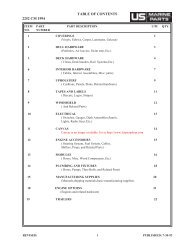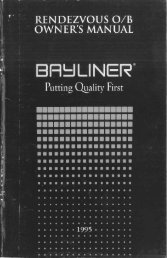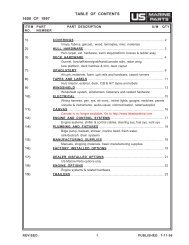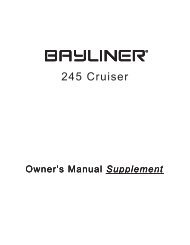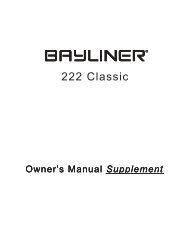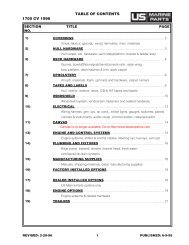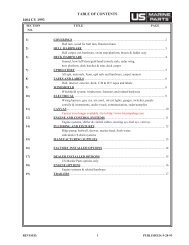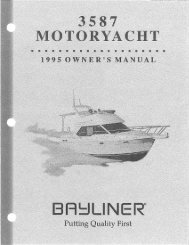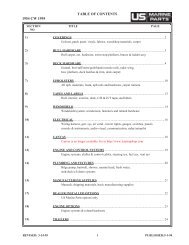2655SD.pdf (5.85 MB) - Bayliner Parts
2655SD.pdf (5.85 MB) - Bayliner Parts
2655SD.pdf (5.85 MB) - Bayliner Parts
Create successful ePaper yourself
Turn your PDF publications into a flip-book with our unique Google optimized e-Paper software.
Engine Serial Number:<br />
Hull Identification Number:<br />
Hull Identification Number<br />
The Hull Identification Number (HIN) is located on the starboard side of the transom. Be sure to record the HIN (and<br />
the engine serial numbers) in the space provided above. Please refer to the HIN for any correspondence or orders.<br />
HIN LOCATION<br />
© 2000 <strong>Bayliner</strong> Marine Technical Publications. All rights reserved.<br />
No part of this publication may be reproduced, stored in any retrieval system, or transmitted in any form by any means,<br />
electronic, mechanical, photocopying, recording or otherwise, without prior written permission of <strong>Bayliner</strong>.<br />
Printed in the United States of America.<br />
General Notes<br />
The material in this document is for information only and is subject to change without notice. While reasonable efforts have<br />
been made in the preparation of this document to assure its accuracy, <strong>Bayliner</strong> assumes no liability resulting from errors or<br />
omissions in this document, or from the use of information contained herein.<br />
Due to our commitment to product improvement, <strong>Bayliner</strong> reserves the right to make changes in the product design,<br />
specifications, and equipment at any time without notice or obligation. Illustrations and/or photos may show optional equipment.<br />
All <strong>Bayliner</strong> products meet or exceed USCG (Unites States Coast Guard) and/or NMMA (National Marine Manufacturer’s<br />
Association) construction standards. Manufactured with 1,1,1 Trichloroethane, a substance which harms public health and<br />
environment during the manufacturing process by destroying ozone in the upper atmosphere.<br />
Proprietary Rights<br />
This document discloses subject matter in which <strong>Bayliner</strong> has proprietary rights. The information and design disclosed herein<br />
were originated by and are the property of <strong>Bayliner</strong>. Neither receipt nor possession thereof confers or transfers any right to<br />
reproduce, copy, alter or disclose the document or any part thereof, any information contained therein, or to construct boats or<br />
any item from it, except by written permission from or written agreement with <strong>Bayliner</strong>. This document is to be returned upon<br />
request to <strong>Bayliner</strong>.
CONTENTS<br />
Chapter 1: Welcome Aboard!<br />
1 Dealer Service<br />
1 Boating Experience<br />
1 Engine/Accessories Guidelines<br />
2 Qualified Maintenance<br />
2 Special Care For Moored Boats<br />
3 Safety Standards<br />
3 Hazard Boxes & Symbols<br />
Chapter 2: Features & Systems<br />
4 Dimensions and Tank Capacities<br />
4 Layout View<br />
4 Hull Hardware<br />
5 Transom Hardware<br />
5 Deck Hardware<br />
6 Cockpit Hardware<br />
7 Helm Hardware<br />
8 Boat Lifting<br />
8 Anchor Windlass (Available Through US<br />
Marine <strong>Parts</strong>)<br />
9 Electrical System<br />
10 12 Volt DC System<br />
10 Fuses and Circuit Breakers<br />
10 Batteries<br />
10 Battery Switch<br />
11 Battery Charger (LX models only)<br />
12 Audio Equipment<br />
13 Navigation & Communication Equipment<br />
13 VHF Radio (LX models only)<br />
13 Compass (LX models only)<br />
13 Depth Finder (LX models only)<br />
13 Navigation and Interior Lights<br />
13 Appliances<br />
14 Propulsion<br />
14 Engine<br />
14 Fuel System<br />
14 Fuel Fill and Vent:<br />
14 Fuel Filters:<br />
14 Anti-siphon Valve:<br />
15 Bilge Blower<br />
15 Power Trim and Tilt<br />
16 Trim Tabs<br />
16 Bilge Pumps<br />
17 Autofloat Switches<br />
18 Freshwater Systems<br />
18 Water Heater (LX Models Only)<br />
19 Transom Shower (LX Models Only)<br />
19 Raw Water System<br />
19 Seacocks<br />
19 Raw Water Strainers<br />
20 Marine Head With Holding Tank<br />
20 Macerator (Option)<br />
21 Air Conditioning System (LX Option)<br />
22 Sink and Shower Drains<br />
22 Shower Sump Pump System<br />
22 Canvas Top Installation<br />
23 Warning Label Locations
Chapter 3: Electrical Routings<br />
24 Hull Harnesses Routings<br />
24 AC Hull Harness Routings<br />
25 DC Hull Harness Routings<br />
26 Battery Cable Routings<br />
27 Bonding Harness Routing<br />
28 Deck Harness Routings<br />
Chapter 4: Wiring Schematics<br />
29 DC Electrical System<br />
30 AC Electrical System, Single Shore Power<br />
31 AC Electrical System, Dual Shore Power<br />
(Air Cond. Option)<br />
Limited Warranty<br />
32 What Is Not Covered<br />
32 Other Limitations<br />
32 Your Obligation
CONTENTS
Chapter 1: Welcome Aboard! 1<br />
Chapter 1: Welcome Aboard!<br />
This owner’s manual supplement provides specific information about your boat that is not covered in the owner’s<br />
manual. Study the owner’s manual and this supplement carefully, paying particular attention to the Limited<br />
Warranty in this supplement. Keep the owner’s manual and this supplement on your boat in a secure, yet readily<br />
available place.<br />
Dealer Service<br />
Make sure you receive a full explanation of all systems from the selling dealer before taking delivery of your boat.<br />
Your selling dealer is your key to service. If you experience any problems with your new boat, immediately contact<br />
the selling dealer. If for any reason your selling dealer is unable to help, you can call us direct on our customer service<br />
hotline: 360-435-8957 or send us a FAX: 360-403-4235.<br />
Boating Experience<br />
If this is your first boat or if you are changing to a type of boat you are not familiar with, for your own comfort and<br />
safety, you must obtain handling and operating experience before assuming command of the boat.<br />
Take one of the boating safety classes offered by the U.S. Power Squadrons or the U.S. Coast Guard Auxiliary. For<br />
more course information, including dates and locations of upcoming classes, contact the organizations directly:<br />
• U.S. Power Squadrons: 1-888-FOR-USPS (1-888-367-8777) or on the Internet at: http://www.usps.org<br />
• U.S. Coast Guard Auxiliary: 1-800-368-5647 or on the Internet at: http://www.cgaux.org<br />
Outside the United States, your selling dealer, national sailing federation or local boat club can advise you of local<br />
sea schools or competent instructors.<br />
! WARNING!<br />
CONTROL HAZARD! A qualified operator must be in control of the boat at all times. DO NOT<br />
operate your boat while under the influence of alcohol or drugs.<br />
Engine/Accessories Guidelines<br />
Your boat’s engine and accessories were selected to provide optimum performance and service. Installing a different<br />
engine or other accessories will cause unwanted handling characteristics. Should you choose to install a different<br />
engine or to add accessories that will affect the boat’s running trim, have an experienced marine technician perform a<br />
safety inspection and handling test before operating your boat again.<br />
Please be advised that certain modifications to your boat can result in cancellation of your warranty<br />
protection. Always check with your dealer before making any modifications to your boat.<br />
The engine and accessories installed on your boat come with their own operation and maintenance manuals. Read<br />
and understand these manuals before operating the engine and accessories.<br />
NOTICE<br />
When storing your boat refer to your engine’s operation and maintenance manuals.<br />
Ciera 2655 Sunbridge • Owner’s Manual Supplement
2 Chapter 1: Welcome Aboard!<br />
Qualified Maintenance<br />
Failure to maintain your boat’s systems as designed could violate the laws in your jurisdiction and will expose you<br />
and other people to the danger of bodily injury or accidental death. Follow the instructions provided in the owner’s<br />
manual, this owner's manual supplement, the engine owner’s manual and all accessory instruction sheets/manuals<br />
included in your boat’s owner’s packet.<br />
! WARNING!<br />
To maintain the integrity and safety of your boat, only qualified personnel should perform<br />
maintenance on, or in any way modify: The steering system, propulsion system, engine control<br />
system, fuel system, environmental control system, electrical system or navigational system.<br />
Special Care For Moored Boats<br />
If moored in saltwater or fresh water, your boat will collect marine growth on its hull bottom. This will detract from<br />
the boat’s beauty, greatly affect its performance and may damage the gelcoat.<br />
• Periodically haul the boat out of the water and scrub the hull bottom with a bristle brush and a solution of soap<br />
and water.<br />
NOTICE<br />
• To help seal the hull bottom and reduce the possibility of gelcoat blistering on moored boats,<br />
we recommend the application of an epoxy barrier coating, such as INTERLUX, Interprotect<br />
2000E/2001E. The barrier coating should be covered with several coats of anti-fouling paint.<br />
• Many states regulate the chemical content of bottom paints in order to meet environmental<br />
standards. Check with your local dealer about recommended bottom paints, and about the<br />
laws in effect in your area.<br />
Ciera 2655 Sunbridge • Owner’s Manual Supplement
Safety Standards<br />
Chapter 1: Welcome Aboard! 3<br />
Your boat’s mechanical and electrical systems were designed to meet safety standards in effect at the time it was<br />
built. Some of these standards were mandated by law, all of them were designed to insure your safety, and the safety<br />
of other people, vessels and property.<br />
In addition to reading this owner’s manual supplement, read the owner’s manual and all accessory instruction<br />
sheets for important safety standards and hazard information.<br />
Hazard Boxes & Symbols<br />
DANGER!<br />
PERSONAL SAFETY HAZARD! Do not allow anyone to ride on parts of the boat<br />
not designated for such use. Sitting on seat backs, lounging on the forward deck,<br />
bow riding, gunwale riding or occupying the transom platform while underway is<br />
especially hazardous and will cause personal injury or death.<br />
The hazard boxes and symbols shown below are used throughout this supplement to call attention to potentially<br />
dangerous situations which could lead to either personal injury or product damage. Read these warnings carefully<br />
and follow all safety instructions.<br />
!<br />
!<br />
DANGER!<br />
This box alerts you to immediate hazards which WILL cause severe personal injury or death if<br />
the warning is ignored.<br />
! WARNING!<br />
This box alerts you to hazards or unsafe practices which COULD result in severe personal<br />
injury or death if the warning is ignored.<br />
! CAUTION!<br />
This box alerts you to hazards or unsafe practices which COULD result in minor personal<br />
injury or cause product or property damage if the warning is ignored.<br />
NOTICE<br />
This box calls attention to installation, operation or maintenance information, which is important<br />
to proper operation but is not hazard related.<br />
EXPLOSION<br />
HAZARD!<br />
OPEN FLAME<br />
HAZARD!<br />
HOT<br />
HAZARD!<br />
ELECTRICAL<br />
HAZARD!<br />
PERSONAL INJURY<br />
& FALLING HAZARD!<br />
ROTATING<br />
PROPELLER HAZARD!<br />
Ciera 2655 Sunbridge • Owner’s Manual Supplement
4 Chapter 2: Features & Systems<br />
Chapter 2: Features & Systems<br />
Dimensions and Tank Capacities<br />
Overall<br />
Length<br />
Bridge<br />
Clearance<br />
Beam<br />
Draft<br />
(Drive Up)<br />
Fuel Capacity<br />
(gal)<br />
Freshwater<br />
Capacity (gal.)<br />
Waste Holding Tank<br />
Capacity (gal.)<br />
27’0" 6’9" 9’1" 1’5" 89 30 20<br />
Layout View<br />
stowage<br />
beneath<br />
folding<br />
transom<br />
seat<br />
transom<br />
door<br />
cooler niche<br />
under lounge<br />
table<br />
engine<br />
hatch<br />
mid ship<br />
cleats<br />
fold down<br />
SunChaiser<br />
lounge<br />
stowage<br />
under<br />
helm<br />
seat<br />
TM<br />
helm<br />
bench<br />
seat<br />
stowage<br />
double<br />
mid-berth<br />
steps<br />
trash in<br />
bin<br />
sink w/<br />
storage<br />
under<br />
stove<br />
head<br />
sink<br />
quick drop<br />
table<br />
converts<br />
to larger<br />
forward<br />
v-berth<br />
storage<br />
under<br />
berth w/<br />
stowage<br />
under<br />
mid ship<br />
cleats<br />
Hull Hardware<br />
FUEL AND<br />
WASTE VENTS<br />
AFT BILGE<br />
PUMP<br />
STORAGE<br />
DRAIN<br />
STBD. HULLSIDE<br />
BOW EYE<br />
COCKPIT<br />
DRAINS<br />
FWD. BILGE<br />
PUMP<br />
SHOWER<br />
SUMP<br />
HEAD<br />
SINK<br />
WATER TANK<br />
VENT<br />
PORT HULLSIDE<br />
ANCHOR<br />
LOCKER<br />
DRAIN<br />
AIR COND.<br />
OVERBOARD<br />
(OPTION)<br />
AIR COND.<br />
DRAIN<br />
(OPTION)<br />
GALLEY<br />
DRAIN<br />
COCKPIT<br />
DRAINS<br />
Ciera 2655 Sunbridge • Owner’s Manual Supplement
Chapter 2: Features & Systems 5<br />
Transom Hardware<br />
TRANSOM<br />
TRIM TAB<br />
(TYPICAL)<br />
STERN EYE<br />
(TYPICAL)<br />
GARBOARD<br />
DRAIN<br />
MACERATOR<br />
DISCHARGE (OPTION)<br />
RETRACTABLE<br />
BOARDING LADDER<br />
Deck Hardware<br />
FORE DECK HARDWARE<br />
AFT DECK HARDWARE<br />
AFT<br />
FWD.<br />
NAVIGATIONAL<br />
LIGHT (TYPICAL)<br />
BOW ANCHOR ROPE CHOCK DECK<br />
CLEAT ROLLER (TYPICAL) PIPE<br />
WATER<br />
FILL<br />
GRAB<br />
HANDLES<br />
WASTE<br />
PUMP-OUT<br />
FITTING<br />
DECK<br />
CLEAT<br />
(TYPICAL)<br />
FUEL<br />
FILL<br />
Ciera 2655 Sunbridge • Owner’s Manual Supplement
6 Chapter 2: Features & Systems<br />
Cockpit Hardware<br />
VIEW OF FORWARD COCKPIT<br />
FWD.<br />
FOREDECK ACCESS<br />
THROUGH OPENING<br />
CENTER SECTION<br />
OF WINDOW<br />
CABIN DOOR<br />
HELM AREA<br />
PORT LOUNGE<br />
SEAT<br />
HELM SEAT<br />
CUP HOLDERS<br />
STORAGE AREA<br />
AND BATTERY<br />
SWITCH ACCESS<br />
STBD.<br />
VIEW OF AFT COCKPIT (LOOKING AFT)<br />
PORT<br />
TRANSOM<br />
DOOR<br />
AFT COCKPIT<br />
BENCH SEAT<br />
TRANSOM<br />
STORAGE<br />
BASE FOR<br />
COCKPIT TABLE<br />
BILGE ACCESS<br />
HATCH<br />
Ciera 2655 Sunbridge • Owner’s Manual Supplement
Chapter 2: Features & Systems 7<br />
Helm Hardware<br />
INSTRUMENT PANEL<br />
FUEL GAUGE VOLTMETER TRIM TAB TEMPERATURE DEPTH FINDER<br />
GAUGE GAUGE GAUGE<br />
OIL PRESSURE<br />
GAUGE<br />
TACHO-<br />
METER<br />
SPEEDO-<br />
METER<br />
HORN<br />
SWITCH<br />
FWD. & AFT<br />
BILGE PUMP<br />
SWITCHES<br />
ACCESSORY SWITCH PANEL<br />
ANCHOR<br />
LIGHTS<br />
NAVIGATION<br />
LIGHTS<br />
WIPER<br />
SWITCH<br />
BLOWER<br />
SWITCH<br />
IGNITION<br />
ACCESSSORY<br />
SWITCHES<br />
COCKPIT<br />
LIGHTS<br />
VHF RADIO<br />
TRIM TAB<br />
SWITCHES<br />
INSTRUMENT<br />
PANEL<br />
WINDLASS<br />
CONTROLS<br />
(OPTION)<br />
12 VOLT<br />
ADAPTER<br />
TILT<br />
STEERING<br />
SWITCH<br />
PANEL<br />
CIRCUIT<br />
BREAKERS<br />
Ciera 2655 Sunbridge • Owner’s Manual Supplement
8 Chapter 2: Features & Systems<br />
Boat Lifting<br />
• Always follow the lift equipment’s instructions and requirements.<br />
• If bilge water is present, pump water out of the bilge areas before lifting your boat. Excessive amounts of bilge<br />
water can shift and change the balance of the load.<br />
• When lifting your boat, always position the lifting slings at the fore and aft sling label positions.<br />
!<br />
CAUTION!<br />
PRODUCT OR PROPERTY DAMAGE HAZARD!<br />
When lifting any boat always use a spreader bar. The spreader bar must be equal to the width<br />
of the boat at the lifting point. Always secure the slings to one another to prevent the forward<br />
sling from sliding up along the forefoot of the boat.<br />
Lifting sling positions shown on this drawing<br />
are typical for port and starboard sides.<br />
FOREFOOT<br />
TYPICAL TWO<br />
3 1/2"<br />
LABELS PER SIDE<br />
42 1/2"<br />
Anchor Windlass (Available Through US Marine <strong>Parts</strong>)<br />
An anchor windlass is available through<br />
US Marine parts. Read the manufacturer’s<br />
instruction manual, before using<br />
the anchor windlass for the first time.<br />
• The windlass can be controlled from a<br />
switch at the helm or from the deck<br />
foot switches.<br />
• Verify that the windlass breaker is<br />
activated before using the anchor<br />
windlass.<br />
• To haul the anchor, use engine power<br />
(not the windlass) to move the boat to,<br />
and directly above, the anchor. Activate<br />
the windlass to disengage the<br />
anchor from the bottom by pulling it<br />
straight up.<br />
WINCH “DOWN”<br />
SWITCH (TYPICAL)<br />
!<br />
ANCHOR<br />
WINDLASS<br />
ROPE<br />
CHOCK<br />
(TYPICAL)<br />
CAUTION!<br />
VIEW OF FOREDECK<br />
ANCHOR ROLLER<br />
NAVIGATIONAL<br />
LIGHT (TYPICAL)<br />
FWD.<br />
WINCH “UP”<br />
SWITCH (TYPICAL)<br />
PRODUCT DAMAGE HAZARD! Do not pull the boat to the anchor using the windlass or continue to<br />
operate the windlass if it has stalled or is overloaded.<br />
Ciera 2655 Sunbridge • Owner’s Manual Supplement
Electrical System<br />
Chapter 2: Features & Systems 9<br />
Thoroughly read and understand this section and the electrical sections of the owner’s manual and all accessory manuals<br />
included in your boat owner’s packet. Electrical routing drawings are provided in Chapter 3 of this supplement,<br />
wiring schematics in Chapter 4.<br />
!<br />
DANGER!<br />
EXTREME FIRE, SHOCK & EXPLOSION HAZARD!<br />
• To minimize the risks of fire and explosion, NEVER install knife switches or other arcing<br />
devices in the fuel compartments.<br />
• NEVER substitute automotive parts for marine parts. Electrical, ignition and fuel system<br />
parts were designed and manufactured to comply with rules and regulations that minimize<br />
risks of fire and explosion.<br />
• DO NOT modify the electrical systems or relevant drawings.<br />
• Only qualified personnel should install batteries and/or perform electrical system<br />
maintenance.<br />
• Insure that all battery switches are turned OFF before performing any work in the engine<br />
spaces.<br />
!<br />
WARNING!<br />
FIRE, OPEN FLAME & EXPLOSION HAZARD!<br />
• Fuel fumes are heavier than air and will collect in the bilge areas where they can be accidently<br />
ignited. Visually and by smell (sniff test), check the engine and fuel compartments for<br />
fumes or accumulation of fuel. ALWAYS operate the bilge blowers for at least four minutes<br />
prior to engine starting, electrical system maintenance or activation of electrical devices.<br />
• Minimize the danger of fire and explosion by not exposing batteries to open flame or sparks.<br />
It is also important that no one smoke anywhere near the batteries.<br />
! CAUTION!<br />
SHOCK & ELECTRICAL SYSTEM DAMAGE HAZARD! NEVER disconnect the<br />
battery cables while the engine is running since it can cause damage to your boat’s<br />
electrical system components.<br />
NOTICE<br />
Electrical connections are prone to corrosion. To reduce corrosion caused electrical problems,<br />
keep all electrical connections clean and apply a spray-on protectant that is designed to protect<br />
connections from corrosion.<br />
NOTICE<br />
Since the batteries on your boat were dealer-installed, the battery switch positions listed above<br />
may vary. Make sure you’ve had a full explanation of battery switch operation from your selling<br />
dealer.<br />
Ciera 2655 Sunbridge • Owner’s Manual Supplement
10 Chapter 2: Features & Systems<br />
12 Volt DC System<br />
Fuses and Circuit Breakers<br />
The engine is protected by a large<br />
circuit breaker located on the engine.<br />
The accessories are protected by circuit<br />
breakers on the battery switch<br />
panel and by the accessory circuit<br />
breakers located below the steering<br />
wheel. Wires are color-coded to indicate<br />
which accessory each circuit<br />
breaker services. Some items, such as<br />
radios and bilge pumps, may be<br />
fused individually at the unit. Autofloat<br />
switches are fused at the battery.<br />
Batteries<br />
The batteries supply electricity for<br />
lights, accessories and engine starting.<br />
The electrical section of Chapter 8, in<br />
the Owner’s Manual, provides battery<br />
care and maintenance instructions.<br />
POSITION 1<br />
ACTIVATES<br />
BATTERY 1<br />
INSTRUMENT PANEL<br />
POSITION BOTH<br />
ACTIVATES BOTH<br />
BATTERIES<br />
POSITION 2<br />
ACTIVATES<br />
BATTERY 2<br />
OFF<br />
POSITION<br />
BATTERY SWITCH<br />
LOCATED BEHIND<br />
HELM SEAT IN<br />
STORAGE AREA<br />
AFT BILGE<br />
STBD.<br />
BATTERY<br />
Battery Switch<br />
The battery switch (located behind<br />
the helm seat in the storage area) has<br />
four (4) positions (see upper photograph<br />
on right);<br />
VOLTMETER<br />
GAUGE<br />
AFT<br />
PORT<br />
BATTERY<br />
• Position 1 - Battery 1 provides<br />
power for engine starting and accessories. Battery 1 (only) will be charged by the engine alternator when the<br />
engine is running at high idle or faster.<br />
• Position 2 - Battery 2 provides power for engine starting and accessories. Battery 2 (only) will be charged by<br />
the engine alternator when the engine is running at high idle or faster.<br />
• Position "BOTH" - If batteries are low, provides power for engine starting from both batteries. The BOTH position<br />
also allows the charging of both batteries by the engine alternator when the engine is running at high idle or<br />
faster.<br />
• The battery switch should be switched to the OFF position whenever the boat is left unoccupied for long periods<br />
of time.<br />
Table 1: Battery Switch Positions<br />
Battery Switch<br />
Position<br />
Engine<br />
Starting<br />
Accessories<br />
and Lights<br />
Engine Alternator<br />
Battery Charger<br />
POSITION<br />
1<br />
Battery 1<br />
Provides Starting<br />
Power<br />
Battery 1<br />
Provides Power for<br />
Accessories and Lights<br />
Charges<br />
Battery 1<br />
Charges<br />
BOTH<br />
Batteries<br />
POSITION<br />
2<br />
Battery 2<br />
Provides Starting<br />
Power<br />
Battery 2<br />
Provides Power for<br />
Accessories and Lights<br />
Charges<br />
Battery 2<br />
Charges<br />
BOTH<br />
Batteries<br />
BOTH<br />
POSITION<br />
BOTH Batteries<br />
Provide Starting<br />
Power<br />
BOTH Batteries Provide<br />
Accessory Power (not advised<br />
unless engine is running)<br />
Charges BOTH<br />
Batteries<br />
Batteries will NOT<br />
Charge Properly<br />
Ciera 2655 Sunbridge • Owner’s Manual Supplement
Chapter 2: Features & Systems 11<br />
Battery Charger (LX models only)<br />
Your boat may be equipped with a battery charger located on the forward engine<br />
room bulkhead. You must read and understand the battery charger manual before<br />
using the charger.<br />
• The battery charger will charge the boat’s batteries whenever the boat is<br />
plugged into 120 volt shore power.<br />
• For proper charging; turn the battery switch to any position except BOTH.<br />
BATTERY<br />
CHARGER<br />
TO PORT<br />
BATTERY<br />
TO STBD.<br />
BATTERY<br />
TO HOT<br />
WATER TANK<br />
! CAUTION!<br />
• The battery charging systems (alternator and battery charger) are designed to charge conventional<br />
lead-acid batteries. Before installing gel-cell (or other new technology) batteries,<br />
read and follow the battery charger’s operating instructions.<br />
• Loose battery cable connections will damage your battery charger and your boat<br />
Shore Power/110 Volt AC System (LX models only)<br />
!<br />
CAUTION<br />
WATER HEATER DAMAGE HAZARD! DO NOT energize the AC water<br />
heater electrical circuit until the heater is completely filled with water. Even<br />
momentary operation in a dry tank will damage the heating elements. Warranty<br />
replacements will not be made on elements or tank damaged in this<br />
manner. The tank is full if water flows from the tap when the hot water is<br />
turned on in the galley.<br />
TYPICAL<br />
SHORE POWER<br />
RECEPTACLE<br />
TYPICAL AC POWER PANEL<br />
AIR COND.<br />
(OPTION ONLY)<br />
SHORE POWER<br />
INLETS<br />
PORT SIDE<br />
OF DECK<br />
!<br />
DANGER!<br />
FIRE, EXPLOSION & SHOCK HAZARD!<br />
• DO NOT alter shore power connectors and use only compatible connectors.<br />
• Before connecting or disconnecting the shore power cord to your boat, verify all breakers<br />
and switches on the AC master panel are turned OFF.<br />
• To prevent shock or injury from an accidental dropping of the “hot” cord into the water,<br />
ALWAYS attach the shore power cord to the boat inlet first; then to the dockside connection.<br />
When disconnecting from shore power, disconnect the shore power cord from the dockside<br />
connection first.<br />
• NEVER leave a shore power cord connected to the dockside connection only.<br />
• Only use shore power cords approved for marine use. NEVER use ordinary indoor or outdoor<br />
extension cords that are not rated for marine use.<br />
Ciera 2655 Sunbridge • Owner’s Manual Supplement
12 Chapter 2: Features & Systems<br />
!<br />
CAUTION!<br />
FIRE, SHOCK & ELECTRICAL SYSTEM DAMAGE HAZARD!<br />
• NEVER connect dockside power to your boat outside North America unless you have purchased<br />
the international electrical conversion option.<br />
• The simultaneous use of several AC components can result in an overloaded circuit. It may<br />
be necessary to turn off one or more accessories in order to use another accessory.<br />
• Use double insulated or three-wire protected electrical appliances whenever possible.<br />
• Periodically check the shore power cord(s) for deterioration or damage. Damaged or faulty<br />
cords should NEVER be used since the danger of fire and electrical shock exists.<br />
• DO NOT pinch shore power cords in doors or hatches, or coil the shore power cord too<br />
tightly since these situations can generate enough heat to result in a fire.<br />
• If a shore power cord should accidently become immersed in water, THOROUGHLY dry<br />
the blades and contact slots before reusing.<br />
NOTICE<br />
Some dockside installations may be rated less than 30 amps, therefore, you may need to purchase<br />
lower amp adapters. Whenever a lower amp adapter is used, however, there will be a<br />
corresponding drop in supplied power from the dockside system.<br />
Connecting to Shore Power<br />
1. Monitor the AC panel’s polarity indicator lights (next to the line 1 and line 2 master breakers) as follows:<br />
• A GREEN light illuminating after the power cord is plugged into the boats external power receptacle indicates<br />
acceptable electrical power in which you may energize the main breaker switches.<br />
• A RED light, however, indicates reversed polarity, which could cause electrical system damage and possibly<br />
electrical shock injuries. In this case, DO NOT energize the main breaker switches (see warning below).<br />
2. Activate the AC system by turning the main ship/shore breaker to the “DOCKSIDE” position.<br />
3. Turn ON the master breakers and individual component breakers as required.<br />
!<br />
WARNING!<br />
SHOCK & ELECTRICAL SYSTEM DAMAGE HAZARD!<br />
• Monitor the polarity indicator lights EVERY TIME you connect to shore power.<br />
• When connecting to shore power and you encounter a reversed polarity light (RED colored),<br />
DO NOT energize the main breaker switches. Instead, IMMEDIATELY disconnect<br />
the shore power cord (ALWAYS from the dockside receptacle first) and notify marina<br />
management.<br />
Audio Equipment<br />
NOTICE<br />
The voltage on each line can be read by setting the voltmeter selector switch.<br />
The audio equipment installed on your boat has separate manuals (included in your boat’s owner’s packet) that<br />
explains its operating procedures in detail.<br />
NOTICE<br />
AM radio reception may be impaired in areas where reception is limited or anytime the engine<br />
is running.<br />
Ciera 2655 Sunbridge • Owner’s Manual Supplement
Chapter 2: Features & Systems 13<br />
Navigation & Communication Equipment<br />
The owner’s packet contains operation manuals for all navigation & communication equipment installed on your<br />
boat. Thoroughly read and understand these manuals before using these systems. Additionally, read the warnings<br />
below carefully and follow all safety instructions.<br />
VHF Radio (LX models only)<br />
Your boat may include a VHF (Very High Frequency) radio at the helm. The VHF radio can be used to access<br />
weather reports, summon assistance or contact other vessels as permitted by the FCC (Federal Communications<br />
Commission). Be sure to contact the FCC for licensing, rules and regulations concerning VHF radio usage.<br />
Compass (LX models only)<br />
NOTICE<br />
Compass accuracy can be affected by many factors. Have a qualified technician calibrate your<br />
compass. Make sure the technician gives you a deviation card which shows the corrections to<br />
apply in navigational calculations. Keep a copy of the deviation card at the helm.<br />
Depth Finder (LX models only)<br />
! WARNING!<br />
• DO NOT use the depth finder as a navigational aid to prevent collision, grounding, boat<br />
damage or personal injury.<br />
• When the boat is moving, submerged objects will not be seen until they are already under the<br />
boat. Bottom depths may change too quickly to allow time for the boat operator to react. If<br />
you suspect shallow water or submerged objects, operate the boat at very slow speeds.<br />
Navigation and Interior Lights<br />
Read and understand the navigation light section of the owner’s manual. The navigation and interior lights installed<br />
on your boat are of top quality, but you should be aware that failure may periodically occur for a variety of reasons:<br />
• There may be a tripped breaker - reset the breaker switch.<br />
• The bulb may be burned out - carry spare bulbs for replacement.<br />
• A wire may be damaged or may have come loose - repair as required.<br />
• The bulb base may be corroded - clean the base and coat it with non-conductive electrical lubricant.<br />
! CAUTION!<br />
• Avoid the storage of gear where it would block navigation lights from view.<br />
• Be conservative in the use of battery power. Prolonged operation of cabin interior lights<br />
(overnight) will result in a drained battery.<br />
Appliances<br />
All appliances installed on your boat come with their own manuals that contain detailed operating instructions and<br />
important safeguards. Thoroughly read and understand these manuals before operating your boat’s appliances.<br />
• Make sure the AC breaker is activated for the appliance you wish to turn on.<br />
NOTICE<br />
Always keep an approved ABC-type fire extinguisher in galley area.<br />
Ciera 2655 Sunbridge • Owner’s Manual Supplement
14 Chapter 2: Features & Systems<br />
Alcohol/Electric Stove<br />
Your boat may feature an alcohol stove (DX models) or an alcohol/electric stove (LX models). Before using your<br />
stove, read and understand the manufacture’s manual as well as these instructions.<br />
! CAUTION!<br />
To prevent overheating which can destroy the electric burner elements, never attempt to use<br />
both alcohol and electric burners simultaneously (LX models only).<br />
!<br />
WARNING!<br />
Propulsion<br />
Engine<br />
EXPLOSION, SCALDING & FIRE HAZARD!<br />
• DO NOT operate the stove unless you have read the owner’s manual from the manufacturer.<br />
Use these instructions only as a reminder.<br />
• Always keep an approved ABC-type fire extinguisher in galley area.<br />
• Any non-cooking devices on or near your stove during operation are potential fire hazards!<br />
• Do not operate the stove while underway.<br />
• Open flame cooking appliances consume oxygen, this can cause asphyxiation or death. Maintain<br />
open ventilation.<br />
The owner’s packet contains detailed engine operation and maintenance manuals. Be sure to read and understand<br />
these manuals before operating or performing maintenance to the engine.<br />
Fuel System<br />
Fuel Fill and Vent:<br />
The fuel fill is located on the starboard aft deck. The fuel fill<br />
fitting is marked “GAS”. The fuel tank vent is located below<br />
the fuel fill. If you experience difficulty filling the fuel tank,<br />
check to see that the fuel fill and vent lines are free of<br />
obstructions and kinks.<br />
Fuel Filters:<br />
All tanks are equipped with a fine mesh screen filter on the<br />
fuel pickup tube (located inside or on the outside of the tank)<br />
to the fuel line fitting. In addition, when supplied by the<br />
engine manufacturer, a filter is installed on the engine. Fuel<br />
filters should be replaced periodically to ensure they remain<br />
clean and free of debris. Consult your selling dealer or local<br />
marina concerning fuel additives that help to prevent fungus<br />
or buildup in your fuel tank.<br />
STBD.<br />
STBD.<br />
AFT<br />
DECK FITTING<br />
FUEL FILL<br />
FUEL VENT<br />
FITTING<br />
FUEL FILL<br />
HOSE<br />
FUEL VENT<br />
HOSE<br />
Anti-siphon Valve:<br />
Your boat is equipped with an anti-siphon valve, which is<br />
an integral part of the barb fitting on the fuel tank where the<br />
neoprene fuel line attaches. The valve is spring loaded and is<br />
opened by fuel pump vacuum. These valves will prevent<br />
fuel from siphoning from the tank in the event of a fuel<br />
line rupture.<br />
AFT<br />
FUEL TANK<br />
ENGINE<br />
COMPARTMENT<br />
Ciera 2655 Sunbridge • Owner’s Manual Supplement
Chapter 2: Features & Systems 15<br />
NOTICE<br />
If an engine running problem is diagnosed as fuel starvation, check the anti-siphon valve. In the<br />
event the valve is stuck or clogged, it should be changed or replaced while the engine is shut down.<br />
Under NO circumstances should the anti-siphon valve be removed, except in an emergency.<br />
! WARNING!<br />
FIRE/EXPLOSION HAZARD - It is very important that the fuel system be<br />
inspected thoroughly the first time it is filled and at each subsequent filling. For<br />
your safety and the safety of your passengers, the fueling instructions in the<br />
Owner’s Manual must be carefully followed.<br />
! CAUTION<br />
Avoid the storage or handling of gear near the fuel lines, fittings and tank.<br />
Bilge Blower<br />
The bilge blower removes fumes<br />
from the engine compartment and<br />
draws fresh air into the compartment<br />
through the deck vents.<br />
To ensure fresh air circulation,<br />
operate the bilge blower for at<br />
least four minutes before starting<br />
the engine, during starting, and<br />
while operating the boat below<br />
cruising speed.<br />
BILGE BLOWER<br />
SYSTEM<br />
STBD.<br />
TRANSOM<br />
FUEL TANK<br />
ENGINE<br />
COMPARTMENT<br />
BLOWER<br />
BLOWER HOSES,<br />
TO/FROM DECK<br />
LOUVERS<br />
!<br />
WARNING!<br />
EXPLOSION HAZARD!<br />
• Operation of the blower system is not a guarantee that explosive fumes have been<br />
removed. If you smell fuel, DO NOT start the engine. If the engine is already running,<br />
IMMEDIATELY shut OFF the engine and all electrical accessories and investigate.<br />
• DO NOT obstruct or modify the ventilation system.<br />
Power Trim and Tilt<br />
The stern drive on your boat is equipped<br />
with power trim and tilt.<br />
The engine operation manual in your<br />
owner’s packet describes proper power trim<br />
and tilt operation.<br />
TRIM “UP/DOWN”<br />
CONTROL SWITCH<br />
TILT “UP/DOWN”<br />
CONTROL SWITCH<br />
SHIFTER/THROTTLE<br />
CONTROL LEVEL<br />
TRIM/TILT<br />
GAUGE<br />
Ciera 2655 Sunbridge • Owner’s Manual Supplement
16 Chapter 2: Features & Systems<br />
Trim Tabs<br />
The trim tabs may be used to help keep your boat level at<br />
cruising speeds.<br />
The trim tabs are controlled by two rocker switches at the<br />
helm. Before using the trim tabs read and understand the trim<br />
tab operation manual included in your boat’s owner’s packet.<br />
Observe the following:<br />
• Once cruising speed is reached, the port or starboard trim<br />
switch may be used (one at a time) to level the boat. Perform<br />
trim tab adjustment with several short touches to the<br />
switch rather than one long one. After each short touch<br />
allow several seconds for the hull to react.<br />
• The trim tab hydraulic fluid reservoir is located in the<br />
engine compartment. The fluid level must be checked periodically<br />
(at least once a year) and refilled as necessary.<br />
TRIM TAB<br />
COMPONENTS<br />
TRANSOM<br />
TRIM TAB ROCKER<br />
SWITCHES<br />
TRIM TAB<br />
(TYPICAL)<br />
! WARNING!<br />
LOSS OF CONTROL HAZARD!<br />
• Improper use of trim tabs may cause loss of control! DO NOT use trim tabs in a following sea<br />
as they may cause broaching or other unsafe handling characteristics.<br />
• NEVER allow anyone unfamiliar with trim tabs to operate them.<br />
• DO NOT use trim tabs to compensate for excessive unequal weight distribution.<br />
Bilge Pumps<br />
Your boat is equipped with two<br />
impeller-type bilge pumps. The bilge<br />
pumps are automatically controlled<br />
by float switches (see "Autofloat<br />
Switches" on the next page). The<br />
bilge pumps can also be controlled by<br />
switches on the dash.<br />
FWD.<br />
FWD BILGE PUMP LOCATION<br />
STBD.<br />
AFT BILGE PUMP LOCATION<br />
STBD.<br />
AFT<br />
THRU-HULL<br />
AFT BILGE<br />
PUMP &<br />
FLOAT SWITCH<br />
THRU-HULL<br />
FWD BILGE PUMP<br />
& FLOAT SWITCH<br />
NOTICE<br />
Discharge of oil, oil waste or fuel into navigable waters is prohibited by law. Violators are<br />
subject to legal action by the local authorities.<br />
Ciera 2655 Sunbridge • Owner’s Manual Supplement
Chapter 2: Features & Systems 17<br />
Bilge Pump Testing<br />
Bilge pumps must be tested often to verify that they are working properly. To manually test a bilge pump’s operation,<br />
activate the dash-mounted switch and verify that bilge water is pumped overboard. If bilge water is present and the<br />
pump motor is running but not pumping, inspect the discharge hose for a kink or collapsed area. If no problems are<br />
found, check the bilge pump housing for clogging debris as follows:<br />
Bilge Pump Cleaning:<br />
1. Remove the power cartridge:<br />
a. Lift the tab while rotating the fins counterclockwise.<br />
b. Lift out the power cartridge.<br />
c. Clear the outer housing of debris.<br />
2. Reinstall the power cartridge:<br />
a. Make sure the “O” ring is properly seated.<br />
b. Coat the “O” ring with a light film of vegetable or<br />
mineral oil.<br />
c. Align the two cams on either side of the power cartridge<br />
with the two slots on the outer housing and<br />
press the power cartridge into the housing while twisting<br />
clockwise.<br />
d. To ensure proper reinstallation of the power cartridge,<br />
attempt to twist the fins counterclockwise without lifting<br />
the tab: The cartridge should stay in place.<br />
Autofloat Switches<br />
BILGE PUMP<br />
COMPONENTS<br />
Automatic bilge pumps use electromagnetic float (autofloat) switches to automatically activate the pump whenever<br />
bilge water accumulates above a preset level. One autofloat switch is mounted next to the bilge pump it activates,<br />
and is wired directly to the battery so it will normally function even when the boat is completely shut down and<br />
left unattended.<br />
Autofloat switches must be tested often for proper operation as follows:<br />
Float Switch Test:<br />
FLOAT SWITCH TESTING<br />
1. Push the float switch test button up to<br />
activate the bilge pump.<br />
If the pump does not turn on, check the<br />
inline fuse. If the fuse is good but the<br />
switch doesn’t work, it may indicate a<br />
bad switch or possibly a low battery.<br />
2. Push the test button all the way down to<br />
return the float switch back into the<br />
auto mode.<br />
LIGHT<br />
FILM<br />
OF OIL<br />
“O” RING<br />
TAB<br />
CAM<br />
(TYPICAL)<br />
FLOAT SWITCH<br />
TEST BUTTON<br />
POWER<br />
CARTRIDGE<br />
OUTER<br />
HOUSING<br />
SLOT<br />
(TYPICAL)<br />
FIN<br />
FLOAT UP - TEST MODE<br />
BILGE PUMP SHOULD TURN ON<br />
FLOAT DOWN - AUTO MODE<br />
BILGE PUMP SHOULD TURN OFF<br />
! CAUTION!<br />
When test is completed on a float switch, you must push the test button all the way down to the<br />
auto position to turn the switch back into auto mode!<br />
Ciera 2655 Sunbridge • Owner’s Manual Supplement
18 Chapter 2: Features & Systems<br />
Freshwater Systems<br />
WATERLINE ROUTING (DX MODELS ONLY)<br />
WATERLINE<br />
TO GALLEY<br />
AFT<br />
PORT<br />
WATERLINE<br />
TO HEAD<br />
WATER<br />
TANK<br />
WATER<br />
FILTER<br />
WATER<br />
PUMP<br />
WATER FILL<br />
FITTING<br />
AFT PORT<br />
DECK<br />
GALLEY<br />
FAUCET<br />
WATERLINE ROUTING (LX MODELS ONLY)<br />
TO<br />
GALLEY<br />
TRANSOM<br />
SHOWER<br />
HOT<br />
WATER<br />
LINE<br />
TO<br />
HEAD<br />
WATER<br />
TANK<br />
WATER<br />
FILTER<br />
WATER<br />
PUMP<br />
TRANSOM<br />
WATER<br />
PUMP<br />
SWITCH<br />
COLD<br />
WATER<br />
LINE<br />
WATER<br />
HEATER<br />
Your boat is equipped with a pressure-demand (potable) freshwater system. These pressure type (demand) systems<br />
operate when the water pump switch (located behind the galley sink, see illustration above) is in the ON position.<br />
• The water pump’s DC breaker must be turned ON to use freshwater.<br />
• The water pump’s DC breaker should be turned OFF when any of the following occurs:<br />
3 When the boat is not in use.<br />
3 Whenever the water tank is empty.<br />
• The water tank fill fitting is located on the aft port deck, (see illustration on right).<br />
• Drain the freshwater system in winter months and when not in use to prevent damage and to keep stored water<br />
from becoming stagnant and distasteful. Should it become necessary to disinfect the freshwater system, ask your<br />
dealer about treatments available for your boat’s system.<br />
• The water filter, located on the water pump in the bilge, should be inspected and cleaned often.<br />
• The water tank is located on the port side of the bilge.<br />
Water Heater (LX Models Only)<br />
• Your boat may be equipped with a water heater. The water heater is located on the aft port side of the bilge.<br />
• The water heater is connected to the AC power system, therefore, you must verify that the water heater breaker on<br />
the AC panel is turned ON before water will be heated. (SEE CAUTION BELOW).<br />
• Read the manufacturer’s instruction manual in your boat’s owner’s packet and observe the following warnings:<br />
! WARNING!<br />
HOT HAZARD! Water heated by the water heater will reach temperatures high enough<br />
to scald the skin.<br />
! CAUTION!<br />
WATER HEATER DAMAGE HAZARDS!<br />
• DO NOT energize the AC water heater electrical circuit until the heater is completely filled<br />
with water. Even momentary operation in a dry tank will damage the heating elements. Warranty<br />
replacements will not be made on elements or tank damaged in this manner. The tank<br />
is full if water flows from the tap when the hot water is turned on in the galley.<br />
• The water heater must be drained and the power turned OFF when the possibility of freezing<br />
exists.<br />
Ciera 2655 Sunbridge • Owner’s Manual Supplement
Transom Shower (LX Models Only)<br />
Chapter 2: Features & Systems 19<br />
Your boat may feature a freshwater transom shower. It is located on the aft port side of the cockpit. The water pump<br />
switch MUST be activated before using the transom shower. Be sure to read the manufacturer’s operating instructions,<br />
provided in your boat’s owner’s packet.<br />
Raw Water System<br />
Seacocks<br />
Seacocks are valves which are typically used to manage the intake of raw water<br />
through the hull below the water line (raw water intake seacocks). Seacocks<br />
may also be used to discharge waste or water through the hull below the water<br />
line (discharge seacocks).<br />
Seacocks are controlled by a 90º lever and are used on your boat in the following<br />
raw water intake/discharge systems: Engine, (optional) air conditioning system<br />
and marine head (toilet) system.<br />
TYPICAL RAW WATER INTAKE<br />
SEACOCK COMPONENTS<br />
90º<br />
SEACOCK<br />
LEVER<br />
HULL<br />
SECTION<br />
SEACOCK<br />
GASKET<br />
INTAKE<br />
STRAINER<br />
!<br />
CAUTION!<br />
SYSTEM DAMAGE HAZARD! Verify that the system’s seacock is OPEN before the system is<br />
started and keep the seacock open until the system is shut off. Close seacocks whenever the<br />
systems will not be used for long periods of time.<br />
Raw Water Strainers<br />
Raw water strainers are used in water pickup systems to filter incoming raw water. The typical layout is one strainer<br />
for each of the following: Engine, and optional air conditioning system.<br />
Raw water strainers are located near raw water intake valves (seacocks) and should be checked every time you use<br />
your boat for leaks and/or debris. If debris is found, clean the raw strainer as follows:<br />
1. Make sure the component/system (engine, air conditioning system, etc.) that the strainer is connected to is<br />
turned OFF.<br />
2. Close the seacock that sends raw water to the strainer you are about to clean. The seacock must remain closed<br />
until the strainer is completely reassembled.<br />
3. Take apart the raw water strainer.<br />
4. Remove debris.<br />
5. Flush strainer with water.<br />
6. Reassemble the raw water strainer.<br />
7. Open the seacock and check for leaks around the strainer. If no leaks are found, you may activate the component<br />
or system.<br />
!<br />
CAUTION!<br />
• FLOODING HAZARD! The seacock that sends raw water to the strainer must be<br />
CLOSED before disassembling the raw water strainer to prevent the boat from taking on<br />
water through the raw water strainer assembly. Keep the seacock CLOSED until the raw<br />
water strainer is completely reassembled.<br />
• SYSTEM DAMAGE HAZARD! After reassembling the raw water strainer, verify that the<br />
seacock valve is OPEN before energizing the component/system.<br />
Ciera 2655 Sunbridge • Owner’s Manual Supplement
20 Chapter 2: Features & Systems<br />
Marine Head With Holding Tank<br />
Your boat comes equipped with a marine head (toilet)<br />
and waste holding tank system. Be sure to read<br />
the manufacturer’s operation and maintenance<br />
manual (included in your boat’s owner’s packet).<br />
• The marine head installed on your boat uses seawater<br />
to flush waste from the toilet. The seawater<br />
intake valve (seacock) is located under the<br />
entry steps in the cabin.<br />
• Waste is routed directly from the head to the<br />
holding tank.<br />
• The holding tank is plumbed to a fitting on the<br />
deck for dockside pump-out.<br />
• You can determine the content level of the holding<br />
tank by looking at the tank located on the<br />
starboard side of the bilge. Empty the holding<br />
tank at every opportunity.<br />
• If you are unable to pump water into the bowl,<br />
the probable cause is debris in the pump diaphragm.<br />
To remedy this, shut off the seawater<br />
intake valve (seacock) and dismantle the pump.<br />
The pump is generally held together with six<br />
screws (the design is simple and the problem<br />
will be obvious when the pump body is split<br />
open).<br />
To winterize the head, shut off the intake seacock<br />
and pump until the bowl is dry. Remove the drain<br />
plug in the base and pump again to remove all of<br />
the water. Do not fill the bowl with anti-freeze. The<br />
intake seacock should be left closed while the boat<br />
is underway or whenever the boat is left moored in<br />
the water.<br />
Operating the manual flush marine head:<br />
1. Open the head’s seawater intake valve (seacock).<br />
HEAD PICKUP LOCATED<br />
BELOW ENTRY STEP<br />
2. Before using the head, pump enough water into the bowl to wet the sides.<br />
After use, pump until the bowl is clean. Continue pumping a few more times to clean the lines. If excess waste causes<br />
the water to rise in the bowl, stop pumping until the water recedes.<br />
STBD.<br />
HOSE FROM<br />
MARINE HEAD<br />
MARINE HEAD SYSTEM<br />
HOLDING TANK<br />
VENT HOSE<br />
STBD.<br />
WASTE PUMP<br />
OUT FITTING<br />
HOLDING<br />
TANK<br />
AFT<br />
HOLDING TANK<br />
VENT<br />
TO WASTE<br />
PUMP OUT<br />
FITTING<br />
AFT<br />
Macerator (Option)<br />
Before using the macerator<br />
option to pump waste directly<br />
into the water (where regulations<br />
permit) you must:<br />
• Open the underwater discharge<br />
seacock located on<br />
the starboard transom.<br />
• Set the y-valve to direct the<br />
waste to the macerator.<br />
The macerator switches must<br />
be pressed simultaneously for<br />
pumping to occur.<br />
MACERATOR SYSTEM<br />
MACERATOR<br />
TO WASTE PUMP<br />
OUT DECK FITTING<br />
TO MACERATOR<br />
Y-VALVE<br />
TO UNDERWATER<br />
DISCHARGE SEACOCK<br />
MACERATOR<br />
SWITCH<br />
HELM<br />
SHIFT/THROTTLE<br />
LEVER<br />
NOTICE<br />
Check with local authorities for regulations regarding the legal use of marine head systems.<br />
Ciera 2655 Sunbridge • Owner’s Manual Supplement
Chapter 2: Features & Systems 21<br />
Air Conditioning System (LX Option)<br />
Your boat may be equipped with an optional air conditioning system.<br />
Please refer to the air conditioner manual for detailed operating<br />
instructions.<br />
• Before operating the air conditioning system, make sure<br />
the breakers on the AC main distribution panel are activated<br />
and verify the system’s raw water pickup seacock is OPEN.<br />
The seacock must remain OPEN anytime the air conditioner<br />
is in use.<br />
• The raw water pickup strainer should be checked periodically<br />
for debris according to the directions given in the Raw Water<br />
Strainer section of this supplement.<br />
• The sump pump should be periodically cleaned of debris<br />
according to the instructions outlined in the bilge pump section<br />
of this Supplement.<br />
AIR COND.<br />
VENT<br />
AIR COND.<br />
SWITCH PANEL<br />
! CAUTION!<br />
SYSTEM DAMAGE HAZARD! The air conditioning system’s<br />
seacock must be OPENED before turning on an air conditioning<br />
unit and must remain open during operation.<br />
AIR COND.<br />
VENT ON<br />
AFT SIDE OF<br />
GALLEY<br />
AFT AIR<br />
COND. VENT<br />
AIR COND. DUCT ROUTING<br />
GALLEY AIR<br />
COND. VENT<br />
CONNECTS TO<br />
AIR COND. UNIT<br />
AIR COND. UNIT LOCATED IN V-BERTH BUNK<br />
HOSE TO<br />
AIR COND.<br />
UNIT<br />
AIR COND.<br />
OVERBOARD<br />
SEAWATER<br />
PUMP<br />
AIR COND.<br />
UNIT<br />
AFT<br />
SEA WATER<br />
STRAINER<br />
AIR COND.<br />
DRAIN<br />
AIR COND.<br />
SUMP PUMP<br />
PORT<br />
STBD.<br />
SEA WATER<br />
PICK-UP<br />
ENGINE<br />
COMPARTMENT<br />
Ciera 2655 Sunbridge • Owner’s Manual Supplement
22 Chapter 2: Features & Systems<br />
Sink and Shower Drains<br />
Gray water (water from sinks and showers) above<br />
the waterline is gravity drained overboard, while<br />
gray water below the waterline is pumped overboard<br />
using a sump pump.<br />
SHOWER SUMP PUMP<br />
TO STBD.<br />
THRU HULL<br />
Shower Sump Pump System<br />
Water from the head shower is drained overboard<br />
using a sump pump. The sump pump is accessed<br />
from the head sink cabinet (see illustration on<br />
the right).<br />
• The pump switch MUST be activated to use the<br />
shower sump and should be switched OFF when<br />
the shower has drained.<br />
• The filter, located next to the pump, should be<br />
inspected and cleaned often.<br />
SUMP PUMP<br />
ACCESS HATCH<br />
SUMP<br />
PUMP<br />
FILTER<br />
TO<br />
SHOWER<br />
Canvas Top Installation<br />
1. Slide the swivel ends (A) of the main bow (B) over the side windshield frames (C) and insert the pins (D).<br />
2. Unfold the canvas top and slide the swivel ends of the forward legs (E) over the windshield frame and<br />
insert the pins.<br />
3. Slide the eye ends (F) of the aft legs (G) into the deck hinges (H) and insert the pins.<br />
4. No adjustments to the bow jaw slides (I) should need to be made as they are preset during manufacturing. Before<br />
attempting to adjust the jawslide positions, obtain the correct measurements from your selling dealer.<br />
B<br />
C<br />
E<br />
F<br />
H<br />
I<br />
G<br />
A<br />
DETAIL VIEW<br />
DETAIL VIEW<br />
D<br />
Ciera 2655 Sunbridge • Owner’s Manual Supplement
Chapter 2: Features & Systems 23<br />
Warning Label Locations<br />
FOREDECK<br />
WARNING<br />
TRIM TAB WARNING<br />
BLOWER WARNING<br />
WASTE DISCHARGE<br />
WARNING<br />
CARBON MONOXIDE<br />
WARNING<br />
MIDBERTH<br />
WINDOW<br />
OIL DISCHARGE LABEL<br />
(ON UNDERSIDE OF HATCH)<br />
POTABLE<br />
WATER LABEL<br />
WASTE<br />
DISCHARGE<br />
WARNING<br />
FUEL FILL &<br />
FUELING<br />
WARNING<br />
Ciera 2655 Sunbridge • Owner’s Manual Supplement
24 Chapter 3: Electrical Routings<br />
Chapter 3: Electrical Routings<br />
Hull Harnesses Routings<br />
AC Hull Harness Routings<br />
AC PANEL<br />
(LX MODELS)<br />
ELECTRIC STOVE<br />
(LX MODELS)<br />
FORWARD AC HARNESS ROOTING<br />
MICROWAVE GALLEY<br />
AIR COND.<br />
(LX MODELS) OUTLET<br />
(LX OPTION)<br />
FWD.<br />
STBD.<br />
HEAD<br />
OUTLET<br />
REFRIGERATOR<br />
OUTLET<br />
(LX MODELS)<br />
WATER<br />
HEATER<br />
AFT AC HARNESS ROUTING<br />
BATTERY<br />
CHARGER<br />
FWD. TO<br />
AC PANEL<br />
AFT<br />
STBD.<br />
AIR COND.<br />
PUMP<br />
(LX OPTION)<br />
TO DASH<br />
Ciera 2655 Sunbridge • Owner’s Manual Supplement
Chapter 3: Electrical Routings 25<br />
DC Hull Harness Routings<br />
FORWARD DC HARNESS<br />
(LX OPTION)<br />
12 VOLT<br />
ACCESSORY<br />
STEP<br />
LIGHT<br />
WATER PUMP<br />
SWITCH<br />
STEREO<br />
FWD.<br />
BILGE<br />
FWD.<br />
SHOWER<br />
SUMP PUMP<br />
STBD.<br />
TO<br />
HEAD<br />
TO DASH<br />
REFRIGERATOR<br />
(LX OPTION)<br />
AFT DC WIRE ROUTING<br />
TRIM TAB<br />
PUMP<br />
WATER PUMP<br />
BATTERY CHARGER<br />
(LX ONLY)<br />
TO GALLEY<br />
ENGINE<br />
GROUND<br />
ENGINE<br />
PLUG<br />
AFT<br />
BONDING<br />
BLOCK<br />
STBD.<br />
MACERATOR<br />
(OPTION)<br />
GROUNDING<br />
BUSSBAR<br />
BLOWER<br />
TRIM TILT<br />
BILGE<br />
PUMP<br />
FUEL TANK<br />
TO BATTERY<br />
SWITCH<br />
TO DASH<br />
Ciera 2655 Sunbridge • Owner’s Manual Supplement
26 Chapter 3: Electrical Routings<br />
Battery Cable Routings<br />
PORT<br />
BATTERY<br />
POSITIVE BATTERY CABLE ROUTINGS<br />
THROUGH US MARINE<br />
TO WINCH (AVAILABLE<br />
PARTS)<br />
AFT<br />
STBD.<br />
ENGINE<br />
STARTER<br />
TRIM/TILT<br />
PUMP<br />
STBD.<br />
BATTERY<br />
TO BATTERY<br />
SWITCH<br />
TO DASH<br />
NEGATIVE BATTERY CABLE ROUTINGS<br />
PORT<br />
BATTERY<br />
TO WINCH (AVAILABLE<br />
THROUGH US MARINE<br />
PARTS)<br />
ENGINE<br />
GROUND<br />
AFT<br />
ENGINE<br />
STARTER<br />
STBD.<br />
TRIM/TILT<br />
PUMP<br />
STBD.<br />
BATTERY<br />
Ciera 2655 Sunbridge • Owner’s Manual Supplement
Chapter 3: Electrical Routings 27<br />
Bonding Harness Routing<br />
FUEL TANK HEAD PICKUP AIR COND.<br />
(LX OPTION)<br />
AFT<br />
BONDING<br />
BLOCK<br />
MACERATOR<br />
THRU-HULL<br />
(OPTION)<br />
STBD.<br />
GROUNDING<br />
BUSS BAR<br />
AIR COND.<br />
PICKUP<br />
(LX OPTION)<br />
AIR COND.<br />
STRAINER<br />
(LX OPTION)<br />
AIR COND PUMP<br />
(LX OPTION)<br />
Ciera 2655 Sunbridge • Owner’s Manual Supplement
28 Chapter 3: Electrical Routings<br />
Deck Harness Routings<br />
HORN<br />
NAV. LIGHT<br />
(TYPICAL)<br />
SPEAKER<br />
(TYPICAL)<br />
WINDLASS (AVAILABLE<br />
THRU US MARINE PARTS)<br />
V-BERTH<br />
LIGHTS<br />
DINETTE<br />
LIGHTS<br />
WIPER<br />
GALLEY<br />
LIGHTS<br />
HEAD<br />
LIGHTS<br />
ENTRY<br />
LIGHTS<br />
COMPASS<br />
LIGHT<br />
SWITCH<br />
COURTESY<br />
LIGHTS<br />
AFT BERTH<br />
LIGHTS<br />
AFT BERTH<br />
LIGHT<br />
SPEAKER<br />
SPEAKER<br />
COURTESY<br />
LIGHT<br />
COURTESY<br />
LIGHT<br />
FUEL FILL<br />
GROUND<br />
TO GROUND<br />
BLOCK IN HULL<br />
STERN<br />
LIGHT<br />
NOTE:<br />
VIEW IS OF UNDER-<br />
SIDE OF DECK<br />
Ciera 2655 Sunbridge • Owner’s Manual Supplement
Chapter 4: Wiring Schematics 29<br />
Chapter 4: Wiring Schematics<br />
NOTICE<br />
• Wiring diagrams show optional equipment not installed on all models.<br />
• Some boats may come equipped with silver (-) and copper (+) colored speaker wires or red/<br />
black (-) and red/white (+) port speaker wire colors; green/black (-) and green/white (+) starboard<br />
speaker wire colors.<br />
DC Electrical<br />
System<br />
Ciera 2655 Sunbridge • Owner’s Manual Supplement
30 Chapter 4: Wiring Schematics<br />
AC Electrical System, Single Shore Power<br />
Ciera 2655 Sunbridge • Owner’s Manual Supplement
Chapter 4: Wiring Schematics 31<br />
AC Electrical System, Dual Shore Power (Air Cond. Option)<br />
Ciera 2655 Sunbridge • Owner’s Manual Supplement
32 Limited Warranty<br />
Limited Warranty<br />
<strong>Bayliner</strong> warrants to the original purchasers of its 2000 and 2001 model boats, purchased from an authorized dealer, operated<br />
under normal, noncommercial use that the selling dealer will: (A) Repair any structural hull defect which occurs within five (5)<br />
years of the date of delivery; and (B) Repair or replace any parts found to be defective in factory material or workmanship within<br />
one (1) year of the date of delivery.<br />
What Is Not Covered<br />
This limited warranty does not apply to:<br />
1. Engines, drive trains, controls, props, batteries, or other equipment or accessories carrying their own individual warranties;<br />
2. Engines, parts or accessories not installed by <strong>Bayliner</strong>;<br />
3. Plexiglass windscreen breakage; rainwater leakage on runabout models; rainwater leakage through convertible tops; minor<br />
gelcoat discoloration, cracks or crazing or air voids;<br />
4. Hull blisters that form below the waterline;<br />
5. Normal deterioration, i.e. wear, tear, or corrosion of hardware, vinyl, tops, vinyl and fabric upholstery, plastic, metal, wood,<br />
or trim tape;<br />
6. Any <strong>Bayliner</strong> boat which has been overpowered according to the maximum horsepower specifications on the capacity plate<br />
provided on each <strong>Bayliner</strong> outboard boat;<br />
7. Any <strong>Bayliner</strong> boat used for commercial purposes;<br />
8. Any defect caused by failure of the customer to provide reasonable care and maintenance.<br />
Other Limitations<br />
THERE ARE NO OTHER EXPRESS WARRANTIES ON THIS BOAT. TO THE EXTENT ALLOWED BY LAW:<br />
1. ANY IMPLIED WARRANTY OF MERCHANTABILITY OR FITNESS FOR A PARTICULAR PURPOSE IS LIMITED<br />
TO THE DURATION OF ONE YEAR.<br />
2. Neither <strong>Bayliner</strong> nor the selling dealer shall have any responsibility for loss of use of the boat, loss of time, inconvenience,<br />
commercial loss or consequential damages.<br />
3. Some jurisdictions do not allow limitations on how long any implied warranty lasts, so the above limitation may not apply<br />
to you. Some jurisdictions do not allow the exclusion or limitation of incidental or consequential damages, so the above<br />
limitation or exclusion may not apply to you. This limited warranty gives you specific legal rights, and you may also have<br />
other rights which vary from state to state.<br />
Your Obligation<br />
In order to comply with regulations, it is essential that your limited warranty registration card be submitted within 30 days of<br />
delivery of your boat. Return of the limited warranty registration card is a condition precedent to limited warranty coverage.<br />
Before any warranty work is performed, we require that you contact your dealer to request warranty assistance.<br />
YOU MUST GIVE US WRITTEN NOTICE OF YOUR WARRANTY CLAIM PRIOR TO THE EXPIRATION OF YOUR<br />
LIMITED WARRANTY AND ALLOW US AN OPPORTUNITY TO RESOLVE THE MATTER.<br />
We require that you return your boat, at your expense, to your selling dealer or, if necessary, to the <strong>Bayliner</strong> factory. You will be<br />
responsible for all transportation, haulouts and other expenses incurred in returning the boat for warranty service.<br />
<strong>Bayliner</strong> Marine Corporation<br />
PO Box 9029<br />
Everett, WA 98206<br />
Phone: 360-435-8957<br />
FAX: 360-403-4235<br />
Ciera 2655 Sunbridge • Owner’s Manual Supplement
Part Number 1709067<br />
A Brunswick Company<br />
<strong>Bayliner</strong> • P.O. Box 9029 • Everett, WA 98206 • 360-435-5571


